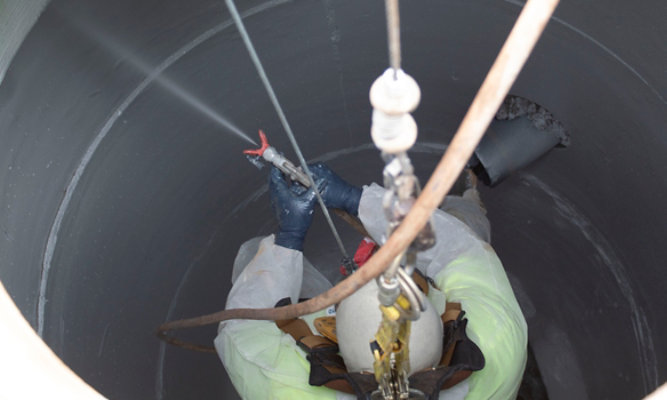
Lining Steel Potable Water Storage Tanks for Efficiency and Longevity
Explore how 100% solids elastomeric polyurethanes compare to 100% solids epoxies as liners for potable storage tanks.
Most owners, specifiers and applicators in the United States choose to line their new or existing potable water storage tanks with epoxy linings, but in Canada this is not the case. There, many specifiers have recognized the benefits of 100% solids elastomeric polyurethane linings over 100% solids epoxy linings. They have been specifying these systems for more than 25 years with admirable results.
As compared to 100% solids epoxies, 100% elastomeric polyurethane linings possess superior elongation properties, which enable them to better withstand thermal expansion and contraction of steel tanks in colder climates. In terms of application efficiency, elastomeric polyurethanes enable significantly higher film builds in one coat, have lower viscosity (less heating required) and cure at lower temperatures.
These benefits are appreciated in northern climates with extreme temperature swings, but they are also relevant in the northern and southern United States, where more projects could benefit from 100% solids elastomeric polyurethane linings over 100% solids epoxy linings.
Superior Elongation Properties
Temperature variances inside a water tank can be quite drastic within a 24-hour period – from freezing to very warm – not only in Canada but in many parts of the United States.
Typical 100% solids epoxy coatings used for potable water tank linings possess elongation properties between 3-4%, while 100% solids elastomeric polyurethanes provide elongation properties of more than 40%. Higher elongation properties make polyurethanes a better choice for any climate with wide temperature fluctuations. This is particularly true for tank roof structures that feature leading edges, support bracing and other nooks and crannies — all areas that tend to fail early with epoxies, due to the effects of thermal cycling.
Nevertheless, both 100% solids epoxy coatings and 100% solids elastomeric polyurethanes are superior to solvent-based, low-solid epoxies when managing thermal cycling.
Effective Abrasion Resistance
Ice formation is closely coupled with thermal cycling. As tank temperatures drop, two to three feet of ice may form inside the tank. This thick, heavy mass of ice floats freely, scraping and hitting the top of the tank and the walls with significant impact. The elastomeric properties inherent within polyurethanes provide enough give to allow the ice to move around without damaging the coating.
Lower-Temperature Curing
The 100% solids epoxy products will cure at temperatures down to 35°F (2°C), but elastomeric polyurethanes enable curing down to 25°F (-4°C). This lower temperature allows applicators to work later in the season and reduces heating requirements for projects, which can reduce application costs.
Higher Film Builds in One Coat
Epoxy resins are capable of film builds of 16-50 mils dry film thickness (DFT) in single applications, but elastomeric polyurethane linings can be applied up to 250 mils (1/4") per NSF International. Therefore, applicators can prefill pits using the same resin system and then topcoat them after the initial pit application sets (usually within 15-30 minutes). Elastomeric polyurethane linings do well on lap seams, tank ceilings, plus bolts and other difficult-to-coat areas.
Lower Viscosity
Because they are less viscous, 100% solids elastomeric polyurethanes require less heat at the pump. They achieve an optimal spray pattern at 80-100°F (27-37°C), whereas 100% solids epoxies typically require heating to 110-130°F (43-54°C). As a result, elastomeric polyurethanes are easier to pump long distances, allowing applicators to stage spray equipment 200-300 feet away from the application site.
Similarities and Differences
Elastomeric polyurethanes and epoxies share many beneficial characteristics:
- They can be applied to holding primers, but achieve maximum adhesion when applied directly to clean blasted steel.
- They provide typical return-to-service times of about 24-72 hours.
- Initial costs and life cycle costs are comparable.
- They provide a minimum life span of 20 to 30 years.
The differences lie in thermal cycling and application characteristics. 100% solids elastomeric polyurethane linings manage thermal cycling better, enable higher film builds with one coat, and provide better coverage of tank roofs and other intricate structural features. In addition, they cure at lower temperatures and require less heat at the pump. Therefore, owners, specifiers and engineers in all geographies should consider elastomeric polyurethanes when planning their next potable water storage tank project.
Let us know what challenges you are facing in your water and wastewater applications. We’d like to help. To reach out to us, please complete our contact form.
Discover More
Industry Expertise and Innovation
See how we help customers find customized solutions for their project and application challenges.
Our Water & Wastewater Expertise
Explore our industry solutions and technology to help protect your assets.
LEARN MOREProduct Lookup
Find out more about our innovative coatings for a variety of industries.
FIND A PRODUCT

